
Morocco lies in the Maghreb region of North Africa overlooking the Mediterranean (north) and Atlantic Ocean (west) with land borders with Algeria (east), and the disputed territory of Western Sahara (south). It also claims a few Spanish exclaves and islands off its coast.
Obviously my only real knowledge of the place comes from the movie Casablanca.
And in reality it was the driving force of us coming to the city. Can’t really come all this way and not visit Casablanca now could we.
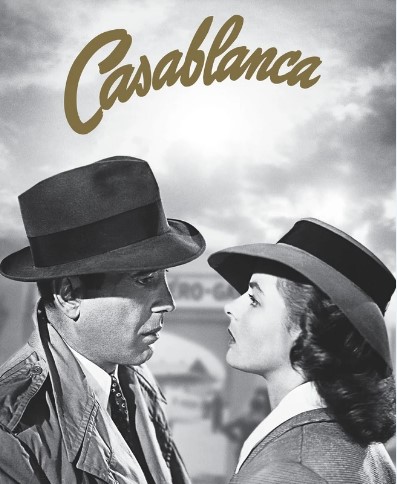
But the region that is now Morocco has been inhabited since the Paleolithic Era (over 300,000 years ago) so there may be a bit more to it than a mere movie.
Rabat
Rabat is the Capital city of Morocco, but we didn’t get there. It is located in the northwest of the country on the Atlantic coast. It was founded in the 12th century when a citadel, mosque and a residence was built. Over the centuries, Morocco’s capital has alternated between the four Imperial Cities being: Fez, Marrakesh, Meknes and Rabat.
The French (when they had control) installed Rabat as capital and it has stayed that way. The pictures look nice, we might have to come back.
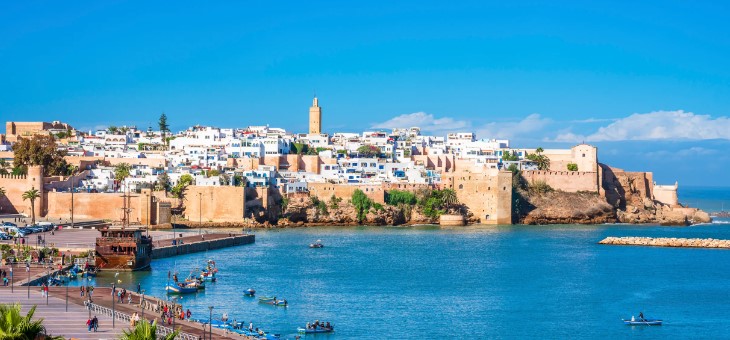
Marrakesh
Marrakesh was our real entry into Morocco, it is the fourth-largest city and was founded in 1071 when it became the capital for the two following centuries. The walls of the city were built in 1122–1123 with other buildings being made with red sandstone earning the city the nickname the “Red or Ochre City”
Marrakesh comprises the original old fortified city (the Medina) and has now outgrown the walls and has a modern city surrounding it. But all of the real action takes place in the walls of the old city, now known as the medina quarter.
Medina Walls
The Medina is an old city and it is surrounded by about 19 kilometres of walls that are made of an orange-red clay and chalk. They stand up to 19 feet (5.8 m) high and have 200 defensive towers along them. Being a thin veneer of bricks and clay, they are constantly under renovation and renewal.




Medina Gates
There are 20 gates in the walls of the Medina with eight main ones holding historical significance. Some of these include: Bab Doukkala, Bab el-Khemis, Bab ad-Debbagh, Bab Aylan, Bab Aghmat, Bab er-Robb, Bab el-Makhzen and Bab el-‘Arissa. These date back to the 12th century during the Almoravid period and many have them have been modified since.
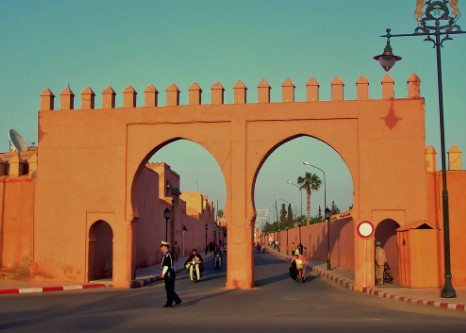
Bab Agnaou, was built in the late 12th century as the main public entrance to the new Kasbah.
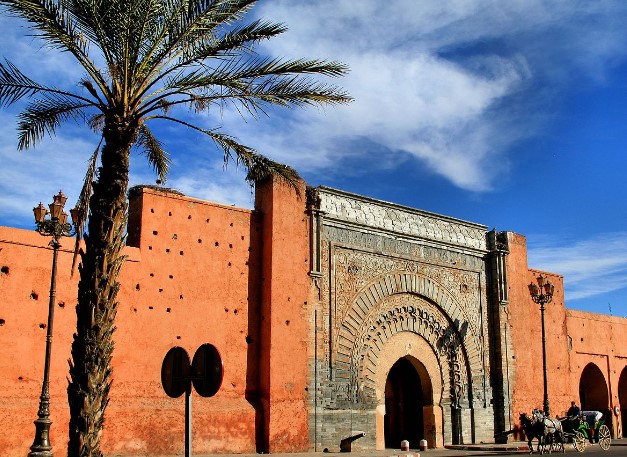
Bab Doukkala (unlike many of the other gates) has not undergone major modifications. The main bus terminal can be found outside this gate.











And all of this we got to experience and take in, before we even got to our accommodation. Arriving at around noon we dropped our bags and immediately set off to take in the Medina and more correctly, the Souk.
Our first stop saw us run into our first attempted scam (a common theme). We pulled in and ordered some fresh pomegranate juice (20 dirham each) and paid with a 100.
I have no change.
All the books tell you about this, I shrugged my shoulders, drank my drink and took my 100 dirham note back.
He found change.
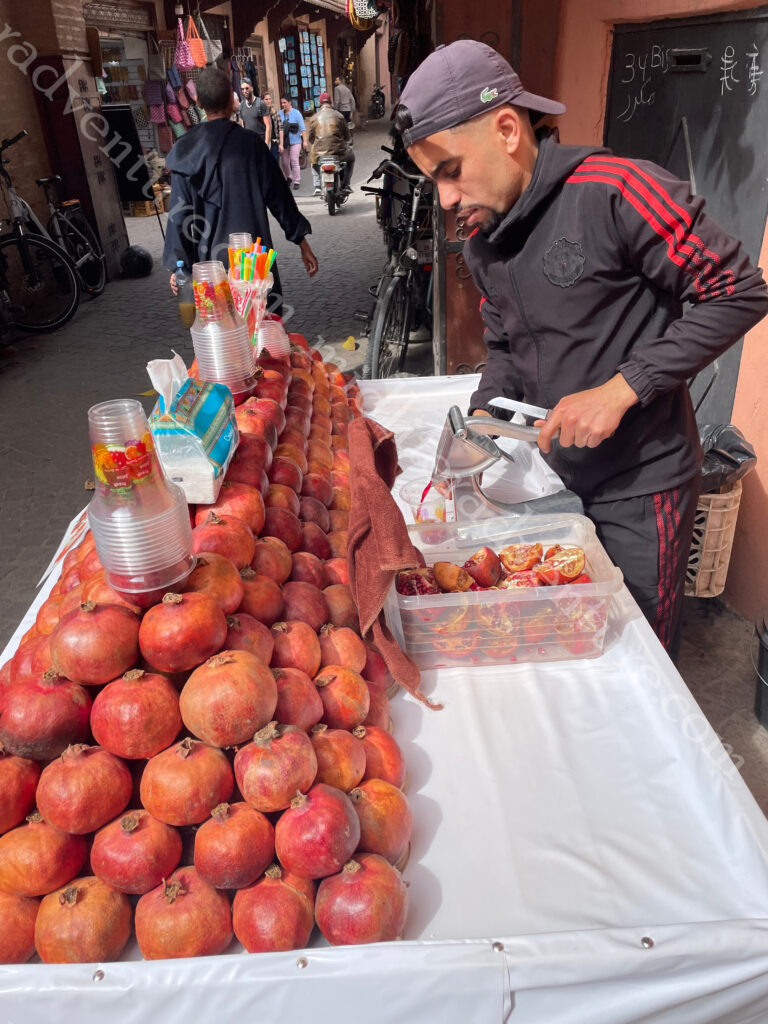
Oh my word, the souk in Marrakesh is a must do experience for everyone. A 100% assault on the senses in every possible manner. There is everything happening and everyone is here. Yelling, screaming, touting, running you over on motorcycles, waving raw meat at you, selling anything that you can think of. And all of this in a maze of tiny backstreets that is all but impossible to navigate.






The best thing to do is embrace it, get lost, explore what is in front of you and just enjoy the experience. Which is exactly what we did. We followed our noses through the mess that was the souk until we (eventually) popped out onto the main square of town.
The Jemaa el-Fnaa is the central square in the middle of the old city and is the busiest square in all of Africa. It is both the economic and tourist centre of modern day Marrakesh. Having just made it through the souk we decided to stop at one of the rooftop restaurants around the square to have a cold drink and take in the goings on.










Being busy we got guilted into buying more than just a cold drink and ended up with a full lunch as well. But our table overlooked (part of) the square and we got to soak it in (in relative peace) before jumping back into the fray. A terrine and a clay pot (of camel) was our lunch of choice, washed down with some fresh juices. If you are ever wondering what to do with a camel, eat it before you ride it.
Lunch over we headed into the square proper for the last of the daytime trade (at around 6 pm the day traders make way for the food stalls and restaurants that take over the square until around midnight). Almost every form of animal exploitation was there just waiting for the tourists to pay money to photograph them. I am sure we missed some but we saw monkeys, snakes, cobras, falcons, turtles and many more.
Having walked through the square we turned the corner and headed down through the park, past the line of horses and carriages ready to take you on a ride around the Medina. But we were aiming for the tallest building in old town.





Standing high above everything in the Medina is Koutoubia Mosque. It is one of the largest and most famous mosques in the city having been built in 1158 with construction finishing around 1195. Its minaret tower is the tallest in the city at 77 metres (253 ft).





A short walk from our accommodation was the Royal Palace which is still in use as one of the official residences of the King of Morocco. Obviously you cannot go in there but it is distinctive for different types of guards hanging out the front of the gate.
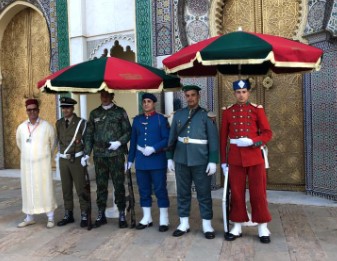
The Souks
The word “souk” is the Arabic and North African name for traditional markets, the Persians prefer the term Bazaar but in this part of the world, souk it is. We hit the main souk in the heart of the Medina and you can literally wander and explore the markets for days. They are filled with food, drink, jewellery, silver, gold, rugs, leather, art, clothing, souvenirs and everything in between.












To say that the main souk at Marrakesh is an experience is seriously underselling the event. It is massive, if you make your way to the Jemaa el Fna Square, you will find the souks branching out from the square, mostly in a winding labyrinth of narrow alleyways. You will get lost. The main souk is called Souk Semmarine, and from here you can just wander and come across all the other souks. Spice Square is easily recognisable with the colors and aromas, Souk el Attarine will be recognisable by the antiques, silver teapots and (genie) lamps. When you start seeing shoes, you’re at Souk Smata and when everything smells of leather, you’ll be in the heart of Souk el Kebir.
As well as the main souk in the heart of the Medina, many smaller ones have sprung up and you can now visit the carpet souk, the leather souk, the shoe souk, the gold souk and the spice souk. Souk Nejjarine specialises in artisanal crafts, particularly woodworking items and offers an array of handcrafted items like lamps, furniture, jewellery boxes, and musical instruments.
Souk El-K, is still in the Medina but is nestled in the Mellah district near the El Badi Palace it is the smallest of the souks, but it is cherished for its brassware.
El Badi Palace is the remains (ruins) of a 15th century palace. It was built to show off the Sultan’s wealth with materials imported from Italy to Mali. The materials were reused in other buildings.
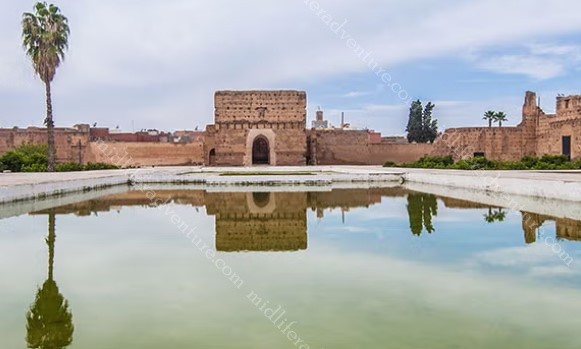
The next day was more exploring through the souk (starting to get a hang of the maze) back into the square and right out to the fringes to get the gate and wall pictures.
The Ben Youssef Mosque is the oldest and most important mosque in the city and sits in the Medina quarter of Marrakesh.
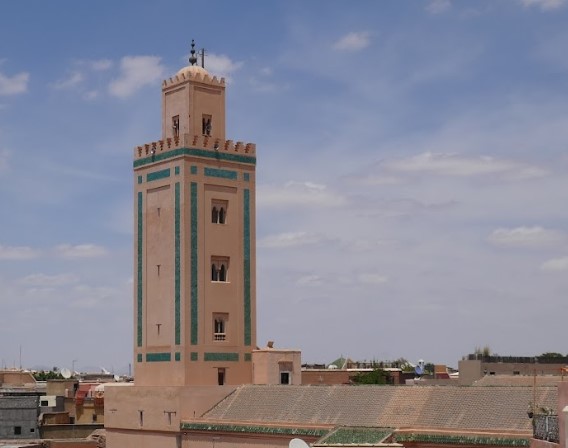
While walking we found coffees and pastries, with a comfortable seat (all this walking, you will need a rest) which was followed a while later (and after more walking) by a local Shawarma plate, and I even managed to get a locally brewed beer.





That night it was back to the square to see exactly what all of these food stalls turned into once the daytime crowd disappeared. And we were not disappointed. Bread and olives, singing chefs, meat on a stick, prawns and calamari, vegetable terrine, more meat on a stick and chilli sauce to make it all a bit interesting.







Jill’s Hat
Who knew but this has taken on a life of its own. When we left Australia the first time around, we both purchased some pretty nondescript but typically Aussie hats to take on our travels. My first effort was a kangaroo skin one that didn’t breathe and made me overheat, so I gave that away to someone that we met on our travels. But Jill’s one was spot on and has continued on throughout, albeit it is now pretty well-weathered.
Over the years she has been placing the souvenirs that we gather (typically lapel pins or tiny trinkets) that are pinned to or sewn onto her hat.
Over time the hat gets full, or heavy, so whenever we go home she tends to drop them off in a souvenir tub and she starts again.
At present there are about 35 different pins from various nations adorning the hat.
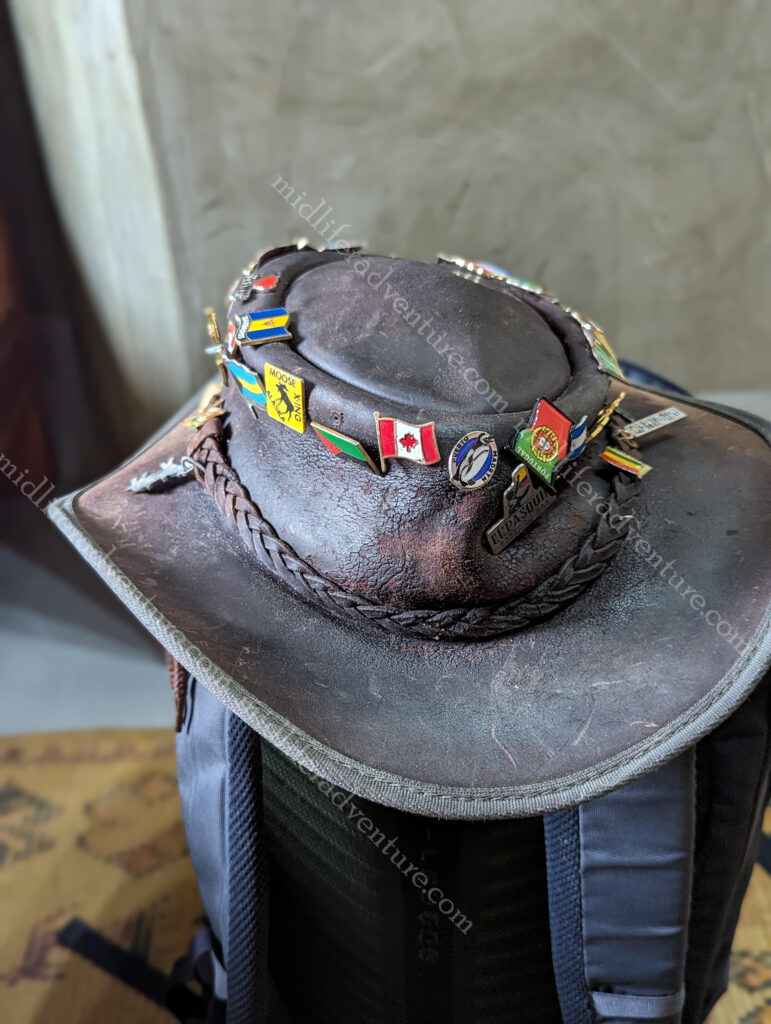
Well we have been out of Australia for 460+ days now and the last drop off was back in September so it is pretty full. Jill did take some off so that it only has 2024 pins on it, but we have done a heap this year already.
Well the notoriety of this hat has been growing and as our journey lengthens and the places we have been to broadens. The hat is becoming increasingly impressive. Today at the Souk a merchant was so taken with her hat that he offered her a choice of anything that was in his (Moroccan Rug) store in exchange for her hat. Now top quality rugs of this ilk run to up to $10,000 and her hat can be replaced for $100 and about $2-5 per pin.
Anyway, that is the hat story, she still has the hat, much to the sadness of a man who pleaded with her to consider the trade.
Essaouira – Getting out of town
Having been souked out after our first two days we decided to organise a day trip out of Marrakesh to the seaside town of Essaouira and we were glad we did. Within minutes of leaving the Medina we were in the main town of Marrakech and a few minutes later we were hurtling along the northern stretches of the Sahara desert.
We had been to Egypt and into the Sahara previously, but it was still a fun experience. It is quite astonishing how quickly the city gives way to sand and urban becomes rural. Goats, sheep, horses and donkeys quickly replaced cars and the pace of the world drops considerably.





Argan oil
OK so this was all new to me. Argan oil is a local product made in Morocco that is obscenely expensive and is used in hair and skin care products.
Beyond cosmetics, it has been claimed to offer health benefits such as immune system support, cholesterol control, potential cancer-fighting properties, anti-aging effects, and wound healing. Argan Oil…more like snake oil.
Anyway, several of the stops that we did along the way were to teach us about this oil, its products and its importance. This included showing us the tree it came from (including the goats sitting in the tree) and then seeing the ‘Women’s Cooperative’ that worked together to extract and produce the Argan Oil and its various products. My scepticism kicked in in full force as a girl with terrible acne was our guide while espousing the virtues of the skin care properties of the product.









As a side note, the goats like to eat the flesh of the olive like fruit, which explains the images of the arboreal goats. Harvesting of (at least some of the nuts) involves collecting the bits that the goats shit out. The oil comes from the kernel within the pip and not from the fruit itself (unlike the olive).
It was a nice stop, interesting to see a centuries old manual process in place (in 2024) and some nice pictures along the way. But it was not for me, Jill did get some of the anti-hair frizz stuff though.
Anyway back to Essaouira, its medina (old town) is a UNESCO listed site. Since the 7th century B.C., the city of Essaouira has been an important regional centre for creativity. The UNESCO World Heritage listed Old Medina of Essaouira because it boasts exceptional spaces for cultural expression, where music takes on its full meaning. What this means to you and me is that you are besieged by random acts of singing at every turn.
It starts on the shoreline with buskers with karaoke speakers belting out tunes at extreme volumes. It then continues to kids making discordant sounds hoping for some change and escalates to roving bands of traditional minstrel’s squawking at you while his mates strangle cats with whatever instruments are on hand, all while you try and enjoy a tagine at the local cafe.






It is surrounded by a 18th-century seafront ramparts called the Skala de la Kasbah, which were designed by European engineers. Old brass cannons line the top of the walls, while vendors line the bottom.








The Medina is very civilised in comparison to Marrakesh, it is calm, very little yelling and plenty of time. There is no pressure. For those looking to get souvenirs but found the souk in Marrakesh overwhelming, then this is for you. Sure you will pay a bit more, but you can think and don’t have every one of your senses under assault. We found it a bit boring after the cut and thrust of Marrakesh.






The place is absolutely buffeted by strong winds (Alizée) that make the city’s crescent shaped beach popular for surfing, windsurfing and kitesurfing. But the winds blow almost all year round, so sadly the beach is useless for almost everything else. The strong winds and dangerous current pretty much rules out sunbathing and swimming. Although we did see on entrepreneur offering horse and camel riding on the wide sandy expanse.

Casablanca
Casablanca is the largest city in Morocco and the country’s economic and business centre. With a population of about 3.71 million, it is one of the most populous cities in the Arab world. The area has been operating as a city and port since the Berbers settled it (called Anfa back then) in the seventh century BC.
In the early 15th century, the town became known as a safe harbour for pirates and privateers until the Portuguese bombarded it to ruins in 1468. It was finally rebuilt between 1756 and 1790, with the help of Spain and the town was renamed ad-Dār al-Bayḍāʼ, the Arabic translation of the Portuguese Casa Branca (White House). French colonialists had their turn in the early 1900’s, once again bombing the city, (killing up to 15,000 Moroccans) burning down the Jewish quarter and ransacking houses. Morocco finally gained independence from France in 1956.
Coming here was a symptom of how good the movie was. Jill did the research and said there wasn’t too much here to see, but I said that we cant come to Morocco and not go to Casablanca. So here we are.












And as it happens, she was right. Very little of the olden area of Casablanca remains, the rest has been swallowed up by the modern city that it is today. We stayed in the Medina (such as it was) with the (very tame) souk directly outside our front entrance. The reality is it is probably a bit over a block in size with normal shops tucked away to look like an olden day market. There are no spices, no jostle or touting, it is just a shopping mall of small shops. Most of what is on offer is European soccer (football) shirts, clothing, luggage and trinkets.
Ricks Cafe
Well we had to hunt it down and find it now didn’t we. The cafe is in a renovated Moroccan mansion with a courtyard built in 1930. Two palm trees stand on either side of the front door. The place opened in 2004, by an American, and is obscenely overpriced, but it does cash in heavily on the tourist saps. And really, you are coming for the experience, so is paying $70 for a steak (when you can have a whole mixed grill somewhere else for $20) unreasonable.



The old mansion was converted to resemble the movie by an American architect who brought back the architectural details of the film. He developed the curved arches, the sculpted bar, the balconies, balustrades, the lighting, the plants and the shadowy white walls. The fireplaces are made from carved marble and painted tiles while the floors are terra cotta.
And of course there is a (Pleyel) piano and music every night Tuesday through Sunday. By the way, in the interests of keeping the experience authentic to the movie, be warned… There is a dress code.
Yes, the place is expensive (especially compared to everything else in Morocco) but it is a theme restaurant and by back home prices it is manageable. It is a destination and an experience and in a Muslim country one of the few places you can get a drink (admittedly at $15 a beer).
Hassan II Mosque
The main mosque in Casablanca can be found down by the water, and it is as huge as it is impressive. It is the largest functioning mosque in Africa and its minaret is the world’s second tallest minaret at 210 metres (behind Algiers). It is one of the few mosques that are open to non-Muslims (for guided tours, at set times).






Casablanca Cathedral
Casablanca Cathedral or Church of the Sacred Heart (although it is not technically a Cathedral as it was never the seat of a bishop) is a former Roman Catholic church located in Casablanca, Morocco. It was constructed in 1930 but ceased its religious function in 1956, after the independence of Morocco.



It subsequently became a cultural centre that is open to visitors.
For the most part, Casablanca is a major city of concrete and steel. But every now and then you come across an area of greenspace that is quite frankly stunning. The gardeners within the parks (these boys know how to use a hedge clipper) do an amazing job of turning this harsh landscape into something truly enjoyable.



Fez
Fez is another reason why we must come back to Morocco. The 1200 year old walled medina of Fez, has 9454 cobbled alleyways, 300 mosques and is both the world’s largest living medieval Islamic city and its largest pedestrian zone.
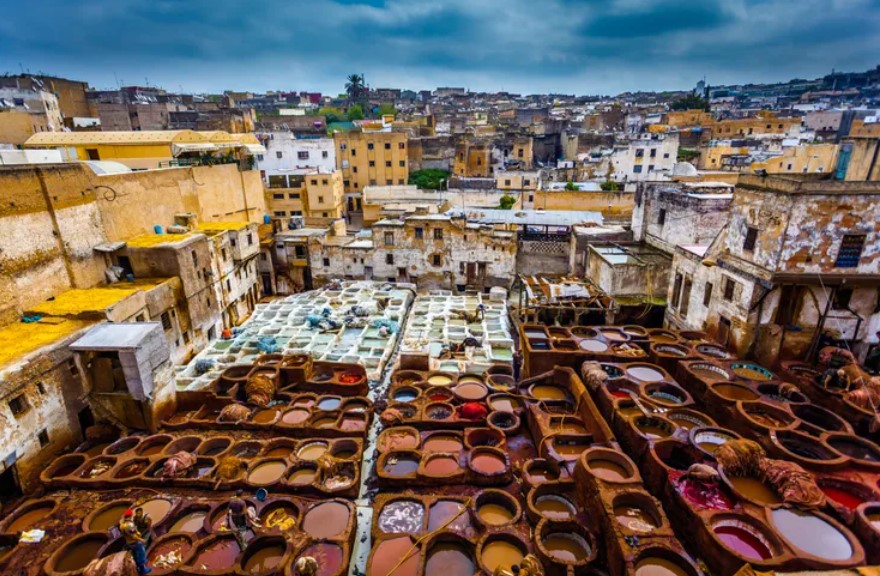
Moroccan Food
The food we have had the whole time we have been here has been magnificent. Almost without exception it is super yummy, and playing lucky dip on the menu (as we tend to do quite often) will not steer you wrong as it is excellent.
Lets start with the most important thing, the Moroccans have a healthy view of the importance of introducing meat to flame. Now any culture that allows meat and flame to come together in such a manner is already highly civilised and should be lauded.





Add to this the proximity to the ocean, and these people do fish and seafood well too.
Couscous is a staple and the one thing that I avoided. I have had them so often and I just don’t see the attraction of these tiny balls of semolina. Here they are traditionally cooked in a steamer over a large metal pot filled with stew until it softens. I have eaten a ton of it, but it is just too bland for my tastes.

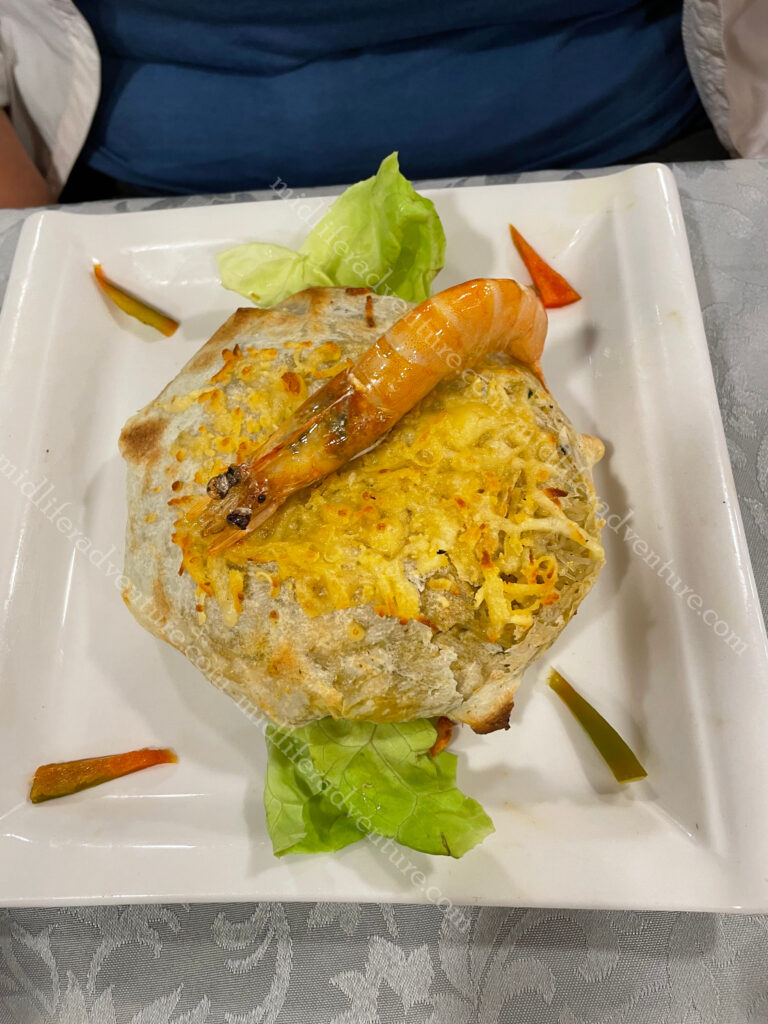
Pastilla is a savoury pie type thing that features layered sheets of thin dough stuffed with a mixture of meat, parsley, onions, spices, and egg.
The chicken version was magnificent, although Jill also managed to find a seafood version.
Tagine is something that we had almost literally every day. Some merely contained Stewed meat, others vegetables, while others had full meals.
It is a staple and it is a good one. I had a particularly good version with meatballs and egg in a rich tomato broth thing.
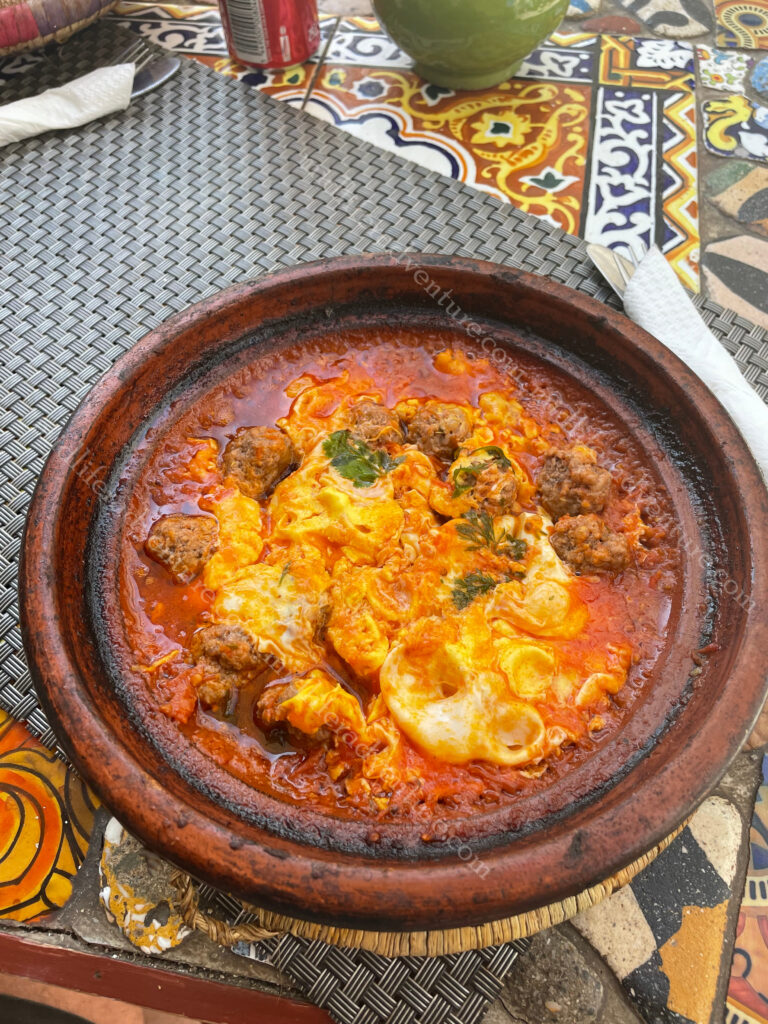

Zaalouk is the side dish of choice. It is made off eggplant and tomatoes and has a smoky flavor. The spice mix includes garlic, coriander, cumin, and paprika, with a healthy splash of olive oil.
Harira is the usual sundown fast breaker for Moroccans during Ramadan. It is a hot bowl of soup filled with rich ingredients of lamb, chickpeas, tomatoes, lentils, chopped coriander and a squeeze of lemon juice. It typically comes with a sticky sweet pretzel known as chebakkiya.

We enjoyed Morocco, and have every intention of coming back. Admittedly, Casablanca was a bit disappointing, but Marrakesh was amazing and Essaouira was highly enjoyable. The trip through the countryside was eye-opening and the people were friendly, the food is the standout and the whole thing (apart from Rick’s Cafe in Casablanca) is cheap.